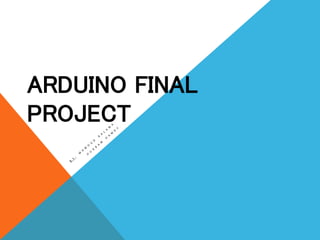
Temperature Sensor with LED matrix Display BY ►iRFAN QADOOS◄ 9
- 2. MAIN PROJECT To make a temperature sensor that outputs the reading as a scrolling message on a LED matrix. We used a LED matrix which is a common anode 8x8 display. Wired on breadboards.
- 3. MAIN CONCEPT Use of two shift registers (2x 74HC595) to pass the encoded- charachter data serially from the arduino as a parallel output to the rows and Columns of an 8x8 LED matrix. The arduino handles the scrolling of the message and the periodic time-multiplexing of rows and columns (refresh rate = 100Hz), using a periodic interrupt, to which the function “screenUpdate” is attached. So , we calibrated the sensor using a potentiometer through the serial monitor window. then the complete circuit is connected.
- 5. 74HC595-SHIFT REGISTERS -- An 8-bit shift register with Serial to parallel capability. -- We use two of them, Each one controlling eight rows/columns.
- 6. LM335-TEMPERATURE SENSOR Calibration: -- We connect the calibration circuit , and connected it’s output as an analogue input to the arduino. -- With a potentiometer, and a small code... we used the serial monitor of arduino to fine-tune the sensor to give an acceptable reading (28°C for average room temperature).
- 7. CODE#include <TimerOne.h> #include <charEncodings.h> // Each charachter and it’s (8x8 LED matrix)-mapped code. // BASIC PIN CONFIGURATION // AND DECLARATIONS //Pin connected to Pin 12 of 74HC595 (Latch) int latchPin = 8; //Pin connected to Pin 11 of 74HC595 (Clock) int clockPin = 12; //Pin connected to Pin 14 of 74HC595 (Data) int dataPin = 11; // pin for the potentiometer to control the scrolling speed int potPin = 5; // pin for reading the temperature int tempPin = 4; // this is the gobal array that represents what the matrix // is currently displaying uint8_t led[8];
- 8. CODE void setup() { //set pins to output pinMode(latchPin, OUTPUT); pinMode(clockPin, OUTPUT); pinMode(dataPin, OUTPUT); pinMode(potPin, INPUT); pinMode(tempPin, INPUT); analogReference(INTERNAL); // attach the screenUpdate function to the interrupt timer // Period=10,000micro-second /refresh rate =100Hz Timer1.initialize(10000); Timer1.attachInterrupt(screenUpdate); }
- 9. CODE //Continuous LOOP void loop() { long counter1 = 0; long counter2 = 0; char reading[10]; char buffer[18]; if (counter1++ >=100000) { counter2++; } if (counter2 >= 10000) { counter1 = 0; counter2 = 0; } getTemp(reading); displayScrolledText(reading); }
- 10. THE (DISPLAYSCROLLEDTEXT ) FUNCTION void displayScrolledText(char* textToDisplay) { int textLen = strlen(textToDisplay); char charLeft, charRight; // scan through entire string one column at a time and call // function to display 8 columns to the right for (int col = 1; col <= textLen*8; col++) { // if (col-1) is exact multiple of 8 then only one character // involved, so just display that one if ((col-1) % 8 == 0 ) { char charToDisplay = textToDisplay[(col-1)/8]; for (int j=0; j<8; j++) { led[j] = charBitmaps[charToDisplay][j]; } } else { int charLeftIndex = (col-1)/8; int charRightIndex = (col-1)/8+1; charLeft = textToDisplay[charLeftIndex];
- 11. // check we are not off the end of the string if (charRightIndex <= textLen) { charRight = textToDisplay[charRightIndex]; } else { charRight = ' '; } setMatrixFromPosition(charLeft, charRight, (col-1) % 8); } int delayTime = analogRead(potPin); delay (delayTime); } }
- 12. void shiftIt(byte dataOut) { // Shift out 8 bits LSB first, // on rising edge of clock boolean pinState; //clear shift register read for sending data digitalWrite(dataPin, LOW); // for each bit in dataOut send out a bit for (int i=0; i<=7; i++) { //set clockPin to LOW prior to sending bit digitalWrite(clockPin, LOW); // if the value of DataOut and (logical AND) a bitmask // are true, set pinState to 1 (HIGH) if ( dataOut & (1<<i) ) { pinState = HIGH; } else { pinState = LOW; } //sets dataPin to HIGH or LOW depending on pinState digitalWrite(dataPin, pinState); //send bit out on rising edge of clock digitalWrite(clockPin, HIGH); digitalWrite(dataPin, LOW); }
- 13. //stop shifting digitalWrite(clockPin, LOW); } boolean isKeyboardInput() { // returns true is there is any characters in the keyboard buffer return (Serial.available() > 0); } } // terminate the string readString[index] = '0'; }
- 14. void setMatrixFromPosition(char charLeft, char charRight, int col) { // take col left most columns from left character and bitwise OR with 8-col from // the right character for (int j=0; j<8; j++) { led[j] = charBitmaps[charLeft][j] << col | charBitmaps[charRight][j] >> 8-col; } } void screenUpdate() { uint8_t col = B00000001; for (byte k = 0; k < 8; k++) { digitalWrite(latchPin, LOW); // Open up the latch ready to receive data shiftIt(~led[7-k]); shiftIt(col); digitalWrite(latchPin, HIGH); // Close the latch, sending the registers data to the matrix col = col << 1; } digitalWrite(latchPin, LOW); shiftIt(~0 ); shiftIt(255); digitalWrite(latchPin, HIGH); }
- 15. void getTemp(char* reading) { int span = 20; int aRead = 0; long temp; char tmpStr[10]; // average out several readings for (int i = 0; i < span; i++) { aRead = aRead+analogRead(tempPin); } aRead = aRead / span; temp = ((100*1.1*aRead)/1024)*10; reading[0] = '0'; itoa(temp/10, tmpStr, 10); strcat(reading,tmpStr); strcat(reading, "."); itoa(temp % 10, tmpStr, 10); strcat(reading, tmpStr); strcat(reading, "C"); }